A Community Approach to 4 year old kindergarten allows families options in providing quality care and education, regardless of ability or family income.
Click on the 4KCA benefit below to read excerpts from …. Bob Kann’s Report “54 Benefits…” and to see the results of our survey of community councils sharing the impact 4KCA has had in their community.
- Provided opportunities for professional development.
- Encouraged staff to improve skills and qualifications.
- Increased sharing of curriculum and resources.
- Improved quality of all early childcare.
- Allowed for fiscal flexibility to improve salary or benefits.
- Provided easier access to school district services.
- Helped programs increase enrollment.
- Provided many financial benefits.
- Increased diversity of children.
- Prompted more interaction, collaboration, and cost sharing.
- Improved image and visibility in community.
26. The 4K Community Approach program has provided community child care and early childhood education programs with professional development opportunities..

The 4K Community Approach program has nurtured collaborative partnerships between school districts and the community child care and early childhood education programs. As a result, school districts commonly offer professional development training sessions which include 4K staff from the community sites. In addition, they often invite the rest of the staff from the community sites including the teachers of younger children to attend the training sessions. Both the 4K teachers and staff of the community programs have improved their practices as a result of the training they’ve received. The community programs, and some early childhood programs which are not even part of the 4K-CA program receive innumerable additional benefits from being able to attend the school district training sessions, including:
• Community-wide staff development presentations for all 4K programs foster better communication and sharing of ideas among staff from different facilities and within the same facilities. These connections improve all of their programs and result in increased collaboration among their sites. 4K staff are also encouraged and sometimes even expected to share what they’ve learned with the child care teachers in their facilities. One program director said, “It’s a fantastic networking opportunity!”
• Specific staff development on curricula such as “Creative Curriculum” or “Conscious Discipline” can build a continuity of instruction and practices within a community site. In Manitowoc, 4K teachers from community sites attended training sessions on Conscious Discipline. They in turn shared what they had learned with staff working with younger children and as a result, the same discipline program was being used within the sites for children in the 4K programs and with younger children, too. Additionally, the teachers of younger children commonly ask the 4K teachers to share what they’ve learned at professional development sessions when they’ve been unable to attend the training sessions.
• Community site directors commonly request professional development training on topics most sought after by their staff. They can take advantage of the school district’s resources to improve the quality of care in their facilities by requesting training specific to their needs.
• Staff at the community sites are able to attend professional development training sessions hosted by the school district in which the presenters are of national stature with commensurate expertise. The sites never would have been able to afford to sponsor such speakers with their own resources, and often lack the resources to even sponsor local speakers.
• Staff from community child care programs who are not part of the 4K Community Approach program sometimes are invited to attend school district staff development programs, which ultimately means that the benefits from the those staff development sessions improve the quality of child care in the entire community.
• Child care teachers and directors feel more confident, respected, and knowledgeable as a result of attending professional development sessions.
Return to top
27. The 4K Community Approach program implicitly encourages some staff to return to school and/or improve their skills and qualifications.

As the 4K Community Approach program has grown in Wisconsin, the opportunities to teach four-year-old kindergarten in community settings has increased. In some of the community settings, staff who previously worked as teacher’s aides and were described as “natural born teachers” returned to school to obtain the appropriate teacher certification. As a result, they received additional training and improved their teaching skills. Linda Gratz, the former Director of Head Start and a member of the Manitowoc School Board, describes how her Head Start program worked with a staff member to help her return to school and get additional training,
“We had a few aides who moved up the ranks, but didn’t have four-year degrees whom we had moved into teaching positions. When 4K came in, we knew our teachers would have to be four-year college graduates and be certified. These two particular teachers were at risk of losing their jobs. One we were able to make into a home-based teacher. She works with children and their parents just in their homes and she didn’t need a four- year degree for that. But we told the other teacher that we wanted to work with her to get a four-year degree. She was a little reluctant to get the degree, but she knew that the 4K was going to begin to expand into different communities and that she was going to need the degree and certification to teach. She eventually went back to UW Oshkosh, got her degree, did her student teaching, and got her license. She is still working with us as our Head Start teacher. If it hadn’t been for the 4K, she probably would never have gone back to school.
To help enable her to go back to school, we were flexible about her work schedule and about giving her the time off for her student teaching, and we helped pay for some of the classes she took. She continued working part-time while she was in school except when she did her student teaching, and then we kept her on for a few hours so that she could keep in contact with the parents and children because she was going to be coming back the other part of the year to work with these children.”
Return to top
28. Curriculum and resources used by the school district are more easily shared and utilized by the child care and early childhood education programs.
Barb Grabel in Madison, Jennifer Trudell in Howard-Suamico, and Jennifer Skibba in Verona talk about smaller child care sites not having to go it alone when using a 4KCA.
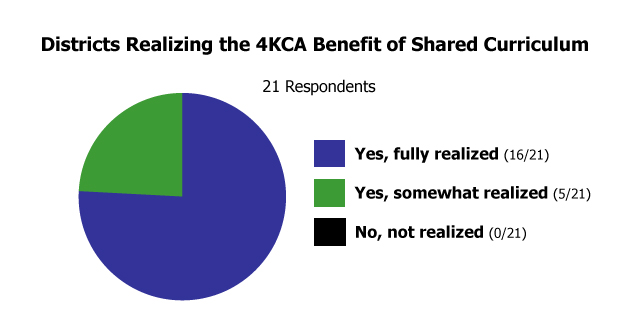
The 4K Community Approach program has brought the curriculums and resources from the school district to the child centers in an unprecedented fashion. School districts now see the community centers as an extension of the school program and they act accordingly in terms of making their resources available to the centers. One community program, for example, received support from its school district to upgrade their computers so that they could utilize the same electronic observation tool for assessment as was being used in the K-12 program. School district materials are commonly shared with the community programs and staff development programs often include staff from the centers. Dennis Krueger, the Assistant Superintendent for the Howard-Suamico School District, said, “Sites have a formal connection to schools and therefore access to the schools’ resources.”
Deborah Shimanek, a Principal and 4K Site Coordinator for the Manitowoc Public School District, explains how staff development on the “Conscious Discipline” curriculum positively impacted the community sites,
“Cathi Burrish {another 4K principal} and myself and the 4K teachers went through Conscious Discipline training and followed up with a trainer of Conscious Discipline, so not only were our 4K teachers trained in Conscious Discipline, but for 3 months in a row, Cathi and I went into the day care sites and did overviews of Conscious Discipline and what Conscious Discipline was all about. That made a huge impact in all of our sites- about being proactive in our discipline, how we can be proactive in planning for the child to support the behavior we want, and what the behavior says about the child. Seeing how the teachers started their morning routines and greeted those children and made it a warm environment, I definitely saw how that has impacted all of our child care sites.”
Deborah Shimanek describes how sharing the Manitowoc School District’s “Creative Curriculum” with the community centers changed their practices,
“…Their {the community sites} interest areas and their small group exploration and play changed a lot. We had a lot of teachers that were doing extended periods of large group things, which we’ve tried to lessen or eliminate. Instead, there’s now lots of exploration in the classrooms about the interest areas. Within the interest areas, allowing children free choice and also allowing the teachers the opportunity to sit down and have good conversations with the children. Snack time now is used as time for language-driven conversation instead of teachers talking to each other. The children were doing no self- serving or anything like that before. We worked hard to make it a child-centered activity instead of an adult-directed activity. So now they have small pitchers, they’re pouring their own drinks, they’re talking about their day, and teachers are sitting at the tables with them instead of talking amongst themselves. That was a huge difference for us. That was a result of the Creative Curriculum.”
Lori Brandt, a Special Education teacher for the Manitowoc School District, describes the benefits of a series of inservice programs the school district presented to the 4K teachers,
“… We did a series of science-related inservice programs throughout the school year through a grant, and we purposefully partnered our 4K partners throughout the school year so that they could go into each other’s classrooms. We tried to put different mixes of teachers together: Head Start with a community site, school program with community site program, etc. to mix it up, to build camaraderie and friendships so that they would share ideas with each other since they’re all spread out rather than in the same building. We wanted to build some cohesiveness among them. We had teacher-partners. When we brought in a woman to do some science experimenting, they were given some release time so that they could go and teach in other’s classrooms for an afternoon or do experiments together with their students. It worked well. They were sharing a lot of ideas, and are now doing more brainstorming with each other and sharing materials than they did before. …The school district helped the community site teachers get release-time and they got substitute teachers in those classrooms to free up the 4K teachers so they could go and be with their partners. The other thing that came out of that is we now have science bins that rotate through the classrooms every month at all the 4K sites so that teachers have, for example maybe one month using a bin on magnets and another month on simple machines. So, they have new things going into their science areas throughout the year. …We took ideas from the teachers to put the bins together during that inservice year. We asked the teachers what resources they were interested in and the teacher who I partnered in this and I found them those resources. It was definitely consumer driven.”
Return to top
29. The 4K Community Approach program improves the quality of the child care and early childhood education programs for all children instead of just benefiting the children in the four-year-old kindergarten programs.
Terri Goettl, Early Learning and Special Education, Eau Claire School District, and Jennifer Trudell, 4K Coordinator, Howard-Suamico, talk about a higher quality education with 4KCA.
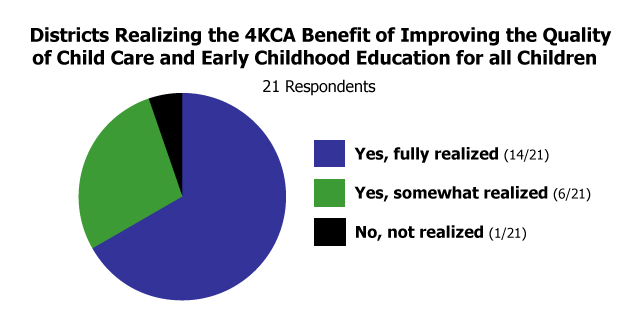
One of the greatest benefits of the 4K Community Approach program has been the unanticipated ways it has improved the overall quality of care for all children in the child care and early education programs in host communities, including:
• 4K teachers can model best practices for child care teachers within the same facility. Jennifer Trudell, the 4K Coordinator for the Howard-Suamico School District, provides an example of how the practices of the 4K teachers “trickle down” to the teachers of two- and three-year-olds,
“One struggle I have had over last four years other than retention of the 4K teachers, has been educating them {the new 4K teachers} on the developmental differences of four-year-olds. In college they were taught about five-year-olds and up, but there’s a vast difference developmentally …So I train them to understand four-year-olds – resulting in another benefit trickling. When other staff observes the 4K teacher- lesson planning wit purpose, documenting the observations of the children- they want to do it, too, because they see it working- not just for the child’s benefit, but to their benefit, too. The staff sees behaviors go away, the kids are getting along and they’re learning and it’s fun. 4K with a community approach has increased our quality across the board- not just the 4K children, but all ages.”
• The 4K Community Approach program has nurtured collaborative partnerships between school districts and the community child care and early childhood education programs. As a result, school districts commonly offer professional development training sessions which include 4K staff from the community sites. They also often invite the child care teachers from the community sites who work with children younger than four-year-olds to attend the training sessions. They sometimes even schedule the trainings during the evening or on Saturdays to better accommodate the scheduling needs of the child care teachers. Both the 4K teachers and the teachers of younger children have improved their practices as a result of the training they’ve received.
• Specific staff development on curricula such as “Creative Curriculum” or “Conscious Discipline” can build a continuity of instruction and practices within a community site. In Manitowoc, for example, 4K teachers from community sites attended training sessions on Conscious Discipline. They in turn shared what they had learned with staff working with younger children. As a result, the same discipline program was used within the sites for children in the 4K programs and with younger children, too.
• Child care teachers and directors feel more confident, respected, and knowledgeable as a result of attending professional development sessions.
• Special services staff from school districts now have a “presence” in the community 4K programs. This increases the contact they have with 4K children, younger children attending child care programs in the same facilities, and the parents of these children, which makes it easier for parents to consult with the school district staff regarding issues of concern with their children.
Deborah Shimanek, Principal and 4K Site Coordinator for the Manitowoc Public School District, explains how 4K-CA has a trickle down benefit in her school district,
“…Some of our 4K teachers in our community-based sites were more child care-oriented versus 4K-oriented. So we really worked hard with the Creative Curriculum with organizing the rooms. What we saw happen was that it carried over into the 3 year olds room, and then we started having conversations with the directors about the toddlers. So that was a huge success- all of us having a common language about creative curriculums, the planning process about Creative Curriculums, and then with the Wisconsin Model Early Learning Standards. We send out 4K teachers to CESA trainings and the expectation is that they’ll go back and share what they’ve learned with the child care staff, too.”
Linda Gratz, Former Head Start Director and current school board member for the Manitowoc School District, describes how staff development improved the quality of child care programs in Manitowoc,
“…It’s been amazing, but not necessarily for Head Start specifically because Head Start has funds for training already and our particular grantee was CESA 7 who already was providing training in early childhood for our Head Start program and for the school district. But after the 4K program got started community-wide, we knew there was a huge need for training for the day care people because the people employed in the child care community have very limited resources and very limited time because they’re always with the children from 6:00 in the morning until 6:00 at night. So there are some real challenges involved to having child care staff trained because of time and money and the resources to follow through. So with the 4K program, it was a fantastic networking opportunity. Not only did the district and CESA and Head Start work together to develop a training program for 4K programs, the school district also was very sensitive to the needs of the day care people. They talked about having trainings at times when school districts weren’t necessarily used to having trainings like in the evenings or on Saturdays.”
Kathy Stachura, the owner of the Cuddle Care Child Care Center in Green Bay, explains how the 4K Community Approach program improved the overall quality of her center,
“I think it’s improved the overall quality of the center. The 4K teachers and my regular teachers communicate very well. My regular teachers ask them for ideas, suggestions- great teamwork has evolved. The district also has provided some awesome trainings that we’d never have been able to afford on our own and some of them we’ve been able to open up to our entire staff. …It gives the entire staff another way of looking at things. They’ve learned new ways, they’ve seen new ways, new techniques, and they’re trying it and moving forward.“
Dennis Krueger, the Assistant Superintendent of Educational Programs for the Howard-Suamico School District, describes some of the trickle-down benefits of 4K Community Approach program in his school district,
“It has brought our community together and heightened the awareness around the importance of four-year-old year old education. It’s supported our existing preschool daycare child care sites in that we’re not taken business away from them and they’ve embraced the criteria we’ve established to be a 4K partner. And, we see trickle down into some of the three-year-old programs in the sites. Also, many of the children were able to stay where they were already attending – a preschool or early learning environment- where they were as infants, one, two, and three-year-olds and were able to continue as four-year-olds. This provides consistency for the child, and some of the process and pedagogy for child trickles down to the three-year-olds- some of the tenets of the Creative Curriculum, the learning through play and exploration and the staff development obtained by the 4K teachers are shared with other teachers within the sites. The {best} practices are used in three-year-old room, too. This helps with continuation from the three-year-old rooms to the four-year-old, too.”
Return to top
30. The 4K Community Approach program can improve the salary and benefits for all staff at the community sites.
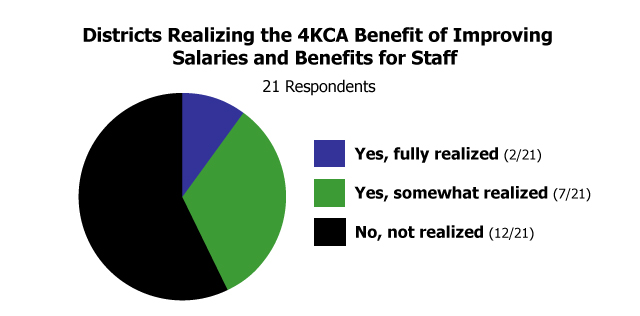
Many of the 4K Community Approach programs allow community sites fiscal flexibility within certain parameters regarding how they allocate their 4K funds. Typically, teacher salaries are the largest expense in 4K programs. Staff retention is often an issue in community child care programs which cannot afford to pay their staff salaries commensurate with the salaries of public school teachers. Some of the community programs have used their 4K funds to raise salaries and add benefits for all their teachers because they believe their teachers deserve to be paid more and this increases the likelihood that there will be continuity in the programs by retaining the same competent staff over an extended period of time.
Return to top
31. The 4K Community Approach program provides community sites easier access to school district services.

The 4K Community Approach program has markedly increased the presence of public school staff in the community 4K venues. Four-year-old kindergarten teachers sometimes are paid employees from the school district. Special services staff who regularly work with children in the community programs are usually school district employees. 4K staff inservice programs often include teachers from both the public schools and community sites, and there are frequent informal conversations which take place between community programs and school district personnel. The result is that the community programs have easier access to school district services; the site’s staff is more willing and able to contact the school district for assistance and/or to brainstorm ideas to help specific children.
Kristine Cresco, Director of Kid’s Castle Child Care Center in Kenosha, explains how her program has better and quicker access to services from the Kenosha Unified School District as a result of the 4K Community Approach program:
“We’ve had a couple of children who have some severe losses, traumas at their young ages. What we’re finding is that when a child is in a 4K environment, we can get services that are needed quicker than before. Yes, we used to get those services from Kenosha Unified, but it took much longer. We can now more easily pull in services to help the teacher to work with that child better and I think parents have really seen the benefits of when we use those services through Kenosha Unified. What a difference those services can make for that child. And how much easier is the transition when that child goes into kindergarten. And, we’re not dealing with those issues later on down the road. In reality, we don’t have all of the services that are available in Kenosha Unified.”
Jennifer Trudell, the 4K Coordinator for the Howard-Suamico School District, describes the benefits for the community sites of having easier access to the public school staff:
“Because of 4K, all of the special education people, speech and language people, physical therapists- all of those interventions are more easily accessible. Sites also have been more willing or able to contact the school district with kids at a younger age, even to just throw around ideas. In the past you’d go to Birth to 3 or you waited until the children got to school. The sites felt like they were on their own. Now we’re able to step in a little earlier. Perhaps by the time they get to 5K, they won’t need any early intervention whatsoever because they’ve had all that early help and assistance.”
Return to top
32. The 4K Community Approach helps child care and early childhood education programs maintain or increase their enrollment.
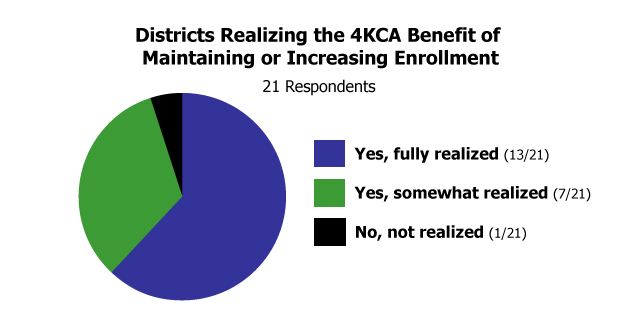
In a community where the 4K program is only in the public schools, the local child care and early childhood programs are at risk of not only losing the four year old population, but also of becoming financially insolvent. Many programs need to balance expensive infant and toddler care that has small child/teacher ratios with the less expensive higher ratio of caring for three and four-year-olds. Without 4 year olds in attendance the programs might not be able to remain open. With the 4K Community Approach parents are more likely to keep their child in the same location for care outside of 4K hours.
Enrollments for community programs might increase with the 4K Community Approach as parents commonly enroll the younger siblings of their four-year-olds in child care programs in the same location that their child is attending 4K. This is more convenient for the parents than having care for their children in different locations and it saves them time and money transporting children to different locations. This also occurs because parents develop more confidence in the capabilities of the child center staff as they become more familiar with the child care program associated with the 4K program. Additionally, after they’ve completed 4K and “graduated” to 5K or became even older, many of these same children continue to attend the same child center for before-and after-school care and summer programs. Some of the teachers for the summer school programs are the same teachers who taught these now older children when they attended 4K, which means they continue to work with children they know well and hence can better attend to their needs, provide guidance and informal instruction, and maintain those strong relationships.
Return to top
33. The 4K Community Approach program provides many financial benefits for child care programs, which typically face considerable fiscal challenges.
Jennifer Trudell, 4K Coordinator, Howard-Suamico, and Barb Grabel in Madison talk about financial benefits using 4KCA.
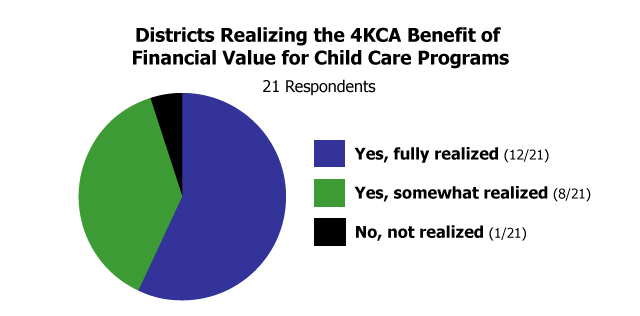
The 4K Community Approach program has provided much-needed financial assistance to child care programs in host communities. While the financial benefits vary from community-to-community, the relative wealth of resources possessed by the school districts have been shared with the child care and early childhood education programs in new collaborative partnerships in which school districts intentionally employ their resources to ensure the financial stability of their community partners. These financial benefits for the community sites include:
• 4K Community Approach programs provide the community sites with financial stability because there is a guaranteed cash flow in the reimbursements for children and rental of teaching rooms. The community sites also know there will be strength in their enrollments because there will be a reliable influx of 4K children in attendance.
• School districts sometimes provide financial assistance to community sites well beyond what might be required for those programs to function, including:
-refurbishing facilities for the community sites
-providing funds to help community sites retain staff when the discrepancy between salaries for the public school teachers and the community sites makes this an issue
-purchasing new materials and equipment for the community sites
-providing community sites funds to replace old equipment or for breakage
-sharing materials and resources from the school district with the community sites
-providing the expertise of special services staff free-of-charge for the community sites
-paying some of the costs for community sites to maintain their facilities
-sharing many transportation costs with the community sites
-providing free advertising for the community sites
• Several community sites have expanded their facilities because the 4K Community Approach has been such a financial boon for their programs.
Return to top
34. The 4K Community Approach program can increase the diversity of children enrolled in community programs.
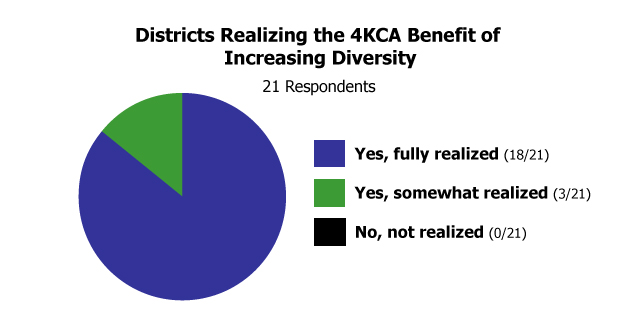
Communities in Wisconsin that have four-year-old kindergarten offer their programs and transportation free-of-charge to four-year-olds at the same level with which they provide transportation to any other K-12 student. As one parent stated, “It’s leveled the playing field. Everyone can attend, not just those who can afford it.”
For many participating community programs, this has meant that the population of children attending their facilities has become more diversified because attendance at the site is no longer dependent on financial resources alone. In addition, Head Start programs which previously enrolled children from low-income families now can provide services and instruction for a more heterogeneous population in terms of family income.
Steve Smith, the CEO of the YMCA in Manitowoc, explains how 4K-CA has increased the diversity of the population at the Y {a 4K host site} and some of the resulting benefits,
“{4K Community Approach} has opened up a great opportunity for us to affect kids in our community that are under the federal poverty line. 17% of children in Manitowoc County are living under the federal poverty guidelines. …And so we’re able to step in and say to the families ‘We want you to be members of the Y’ or ‘There’s an opportunity here for you to participate in the Y beyond the 4K program.’ So it gives us an avenue to speak to that group because not all kids are well off. Our staff knows who they are and are able to help them more.
We have a family in town- illegal immigrants. The father was deported. They went to Mexico. The six-year-old had touched our 4K program before they left. They had four children under the age of 5. After the deportation, the mother and younger children returned to Manitowoc. They’re a scholarship family with us based on the situation of the father leaving town. The community has really stepped up. Their kids are now sleeping on the bunk beds of our kids {Steve Smith’s children’s beds}, two of the kids are in the 4K program, and there’s a child about three-years-old, too. We’ve worked out a scholarship to give that child the opportunity to be in our child care so Mom can work.
Mom is one of our scholarship stories that we’ve told to the community with the impact we’ve made with them and that we’re continuing to try to make. They’re integrated into the life of the organization. Last year, they were a family that our staff took care of for Christmas. We care deeply about this family, and it’s just one of the families that we care deeply about. We’re out there fighting with them- not saying, ‘Good luck. Hope it works out.’ That’s who we are as an organization, and the school district obviously feels the same way. We’re able to make that effect because the kids are in 4K here.
…We often face challenges at the Y of our non-English speaking families. To go back to the story I told you earlier about the family that was deported. That Mom- well here’s the giving back part of that story. Well we’re helping out, we’re giving to them. She’s come back in help us out with translation when we’re struggling. Helping her community out. They’re a Y family for life, and we will reap the rewards of our good work tenfold out in the community by her work and that she believes in the community.”
35. The 4K Community Approach program has prompted more interaction, collaboration, and cost sharing among community child care and early childhood education programs.
Jeff Bindl, Director of Pupil Services in Reedsburg, and Jennifer Trudell in Howard-Suamico, talk about the strength of collaboration in communities using 4KCA.
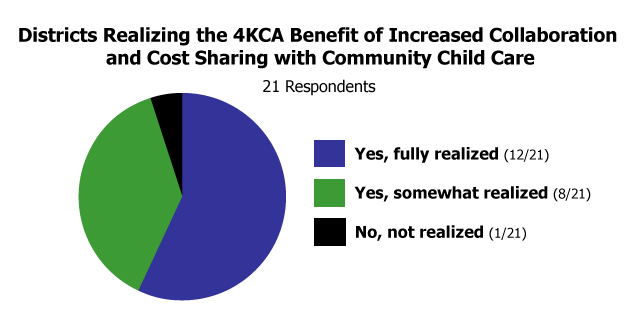
The 4K Community Approach program has forged cohesive early childhood communities. Whereas child care and early childhood education programs often viewed each other as competitors, there’s now a spirit of “what can we do to help each other provide the best possible care for children in our community?” There are many benefits resulting from this new spirit of collaboration, including:
• Increases the frequency of contact and improves the quality of communications among community programs. Community-wide staff development sessions in particular nurture such contact and communication.
• Creates a cohesive community among programs who now share a common goal of helping the entire community provide the best care possible. The effect is as “pulling together” of the entire early childhood community
• Instead of the previous feeling of competition amongst community sites, program directors and staff now commonly refer parents to other facilities.
• Community sites commonly share expenses on joint ventures, such as the costs to charter buses for field trips or staff trainings.
• Community sites share materials.
• Community sites can “share children,” such as merging children from two sites into one 4K classroom, while having the children remain in child care in each separate facility.
• Builds friendships among staff from different facilities, which helps them feel less isolated within the early childhood community.
• Outstanding teachers sometimes serve as mentors or “experts-to-be consulted” for staff at facilities throughout a community.
Garret Bresina, the owner of Kids USA Learning Center in Chippewa Falls, describes how the 4K Community Approach program has increased communication among child care centers,
“Before the 4K Community Approach program, owners and administrators knew each other, but never met or talked to share ideas. Now all the sites meet monthly and we’re involved in a common goal of wanted this to be a great program, not just my program, but for the whole community. We share great ideas with other teachers and other sites… ten years ago I never would have contacted another center to see how they were doing or to ask questions and get ideas. It strengthens the community. Obviously we’re separate businesses and competing, but also being able to help each other and plan with each other and even refer to other sites if ours doesn’t fit a parents need.”
Becky Wright, another Director of Monkey Business Child Center in Chippewa Falls, describes how one outstanding teacher has been a resource for the entire early childhood community,
“We’ve had a teacher who has been here for four years who’s really grown, not only with her classroom, but as a mentor to other teachers that have come on board and other teachers from the school district. She did that because her confidence was built and she could really see what a difference she was making with her children, especially in classroom management skills. That teacher has grown, and it’s more the mentoring portion of it. She’s mentoring the other teachers at Monkey Business and the teachers at other 4K collaborative centers. She would get calls from other centers and they would meet and share ideas. She actually went to one center and helped the teacher with her environment. So it’s not a competition between the centers- it’s more what can we do to help you, what’s working, and what can you do to help me to make it work for my classroom?
Dana Sommerfeld, the Director of State and Federal Programs for the Chippewa Falls School District, describes collaboration between a Head Start program and a program in a Catholic School,
"We have a Head Start program and another site is a Catholic school. We’ve been able to work through all the things that need to be worked through to make it happen. It’s hard to put my finger on it, but it’s the level of collaboration and concern for our children that’s made this work very well.
They follow all guidelines for 4K program that we follow. It’s part of a public school in a private school, but we haven’t had the issues they’ve had in a lot of places about where religion starts and where it ends. They understand the importance of the program and parents whose children are there understand that it’s not a religious program."
Return to top
36. Child care programs can improve their image and increase their visibility in their communities as a result of being participants in the 4K Community Approach program.
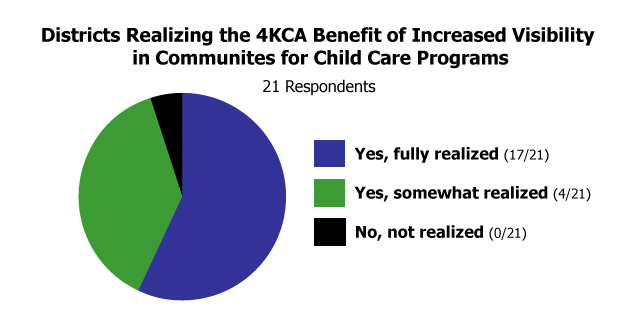
The 4K Community Approach program can improve the public image of participating child care and early childhood education programs. Simply being associated with the public school district gives the community programs an added stamp off credibility. Being part of a successful community-wide collaboration also improves the public image of the early childhood programs. Additionally, free publicity from the school district increases the visibility of the community programs.
In Manitowoc, there are three 4K programs housed in the YMCA. The success of the 4K-Community Approach program collaboration with the Y has improved the public image of the YMCA, the programs housed within the Y including its child care center and 4K programs, and the school district’s image for successfully working with community partners. Steve Smith, the CEO of the YMCA explains,
“…Every dollar we receive from the school district pays back tenfold because people feel connected to us and the community that we’re trying to effect in Manitowoc.”
Kathy Stachura, the owner of Cuddle Care Child Care Center in Green Bay, describes how the 4K Community Approach program increases the exposure of her center,
“…We get a lot of advertising free from the district because the district website lists all the community sites. And, for any advertising they do for 4K, they list all the sites. So it puts your name out in the public so much. And once a year, the district has a get-together and lets parents know what 4K is about. All of the sites are mentioned. It just makes your site much more visible to the public.’
Amy, a parent and board member for the Good Shepherd Preschool in Green Bay, said,
“It’s {4K Community Approach program} connected the Good Shepherd Church to even more of the community. We’ve always had a good reputation in the community, but working with the district helps our reputation, too.”
Return to top










